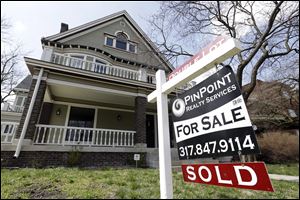
Real: Inspect your neighbors along with your house
4/22/2013
A "Sold" sign is posted outside a home in Indianapolis, Tuesday, April 9, 2013. Real estate agents say pent-up demand and low interest rates are leading to a resurgence in the housing market, with home sales up 20.5 percent statewide through the first two years of the month.
A Russian proverb says: “Don't buy the house, buy the neighborhood.”
Perhaps the most frequently shirked due diligence duty by homebuyers is a thorough screening of the prospective neighborhood -- and of the neighbors. While buyers spend countless resources on inspections, radon tests, surveys, and appraisals, they too often settle for just a cursory examination of the block that's destined to become their habitat.
There's no comparable research in the United States, but a study by Halifax Home Insurance Co. in Britain said 360,000 Brits moved because of bad neighbors in 2010. The most common complaints were aggressive behavior, excessive noise, and unkempt properties.
There's no one-size-fits-all strategy to screening neighborhoods. “Everyone has different things that are important to them,” says Sarah Davis, a broker with Partners Realty of California in San Diego. “A yappy dog may really bother one person and another not much at all.”
With that caution flag unfurled, here are some tips on how to inspect a neighborhood:
Conduct a criminal search. Nothing puts fear in a family faster than the discovery of a sex offender on the block. Moreover, sellers and agents in most states aren't obliged to volunteer information about the presence of nearby sex offenders. Ask pointedly if any listed offenders or previously listed offenders dwell in the neighborhood. Then always follow that up with your own search at the National Sex Offender Public Web site, NSOPW.gov. Sex offenders have been known to cause more than worry wrinkles and less outside playtime; their presence can depress neighboring home values and dampen resale potential.
Don't overlook other crime either. No matter how bucolic an area appears, some neighborhoods are more prone to break-ins, car thefts, and other offenses. For example, subdivisions just off major highways are attractive to thieves because they offer quick getaways.
Case the neighborhood. This requires a different brand of detective work. Most buyers visit prospective neighborhoods only at midday and don't see their complexions change. Inspect the neighborhood at varying hours. Park the car down the street and walk around the block on a Saturday night. Are there any deal breakers such as rowdy neighbors, dogs that bark nonstop, street racing, or airplanes flying low overhead?
Other “watch-outs” include unkempt and cluttered lawns, street-corner lurkers, houses with frequent visitors, too few or too many children, strange odors (from a nearby landfill or industry), ear-splitting train horns, ceaseless traffic din from nearby highways, graffiti, bright streetlights or commercial lighting streaming in windows -- and an abundance of homes for sale or in foreclosure. A good agent can produce lists of both. Too many for-sale homes can signify a neighborhood in transition to mostly rentals.
If you feel bold, politely strike up conversations with folks who live on the street.
Do homework on the neighborhood schools. Real estate agents might be reluctant to talk much about your school district if it isn't exemplary. But there are online resources. School demographics and student-teacher ratios can be found at the National Center for Education Statistics Web site, NCES.ed.gov, by clicking on “School Search,” while school ratings and reviews can be seen at GreatSchools.org.
There's no substitute, however, for a tour to inspect a school's character, safety, and culture. “Ask about class size, enrollment growth, and adequate school funding,” Davis says. “The quality of the school district has a lot to do with resale value.”
Beyond schools, there are other issues. Survey for lot-line land mines. Could your potential new dream home use a new fence? You'd be shocked to see how many presumed yard boundaries are actually wrong by a few feet or more -- and how many neighbors are primed to call you on that fact if you rub them the wrong way after moving in.
And be sure to take a broader view. See and think beyond your immediate block. That empty lot on the corner entrance to your subdivision looks like a great place for neighborhood touch football or soccer, but it may contain an unsavory surprise: commercial zoning. Instead of just another house, that lot may someday yield a convenience store or fast-food restaurant, with the requisite noise, lighting, and traffic. Find out from your agent or the city what's allowed there.
Finally, practice your commute from your prospective neighborhood. A home that's closer to work doesn't necessarily mean a faster drive time because of congested feeder roads and other factors.